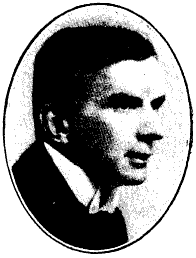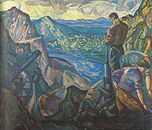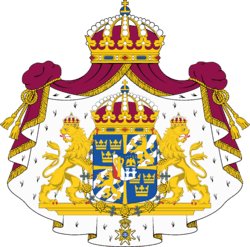Axel Törneman
| Axel Törneman | |
|---|---|
|
Axel Törneman, in Nordisk familjebok | |
| Born |
Johan Axel Gustaf Törneman 28 October 1880 Persberg, Värmland, Sweden |
| Died |
26 December 1925 (aged 45) Stockholm |
| Nationality | Swedish |
| Education |
Värmland School of Art, Kunstakademie München, Adolf Hölzel, Académie Julian |
| Known for | Modern art, Painting; graphic design |
| Movement | Modernism, Expressionism |
| Spouse(s) | Gudrun Høyer-Ellefsen |
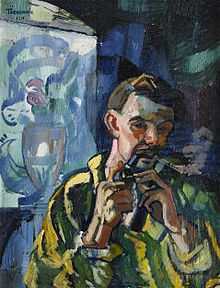
Johan Axel Gustaf Törneman (28 October 1880 – 26 December 1925) was one of Sweden's earliest modernist painters. Born in Persberg, Värmland, in Sweden, he grew to work in several modernist styles, was one of the first Swedish expressionist artists, and became a part of the international avant-garde in art after embracing more abstract art styles in Germany and France that were evolving there during the early 1900s. He created his most famous paintings, Night Café I and II, and Trait, in France in 1905. These night café paintings, made from studies in the Place Pigalle, and in other nightclubs popular with artists such as Café du Rat Mort (Dead Rat Café), are seen as two of Swedish modernism's most important works, and influenced by the German modernists more than by the French.
Törneman gained international stature in 1905 at the Salon d'Automne in Paris with Trait I, and with his Narragansett Café in 1906. He went to paint murals and decorations in public buildings such as the Royal Institute of Technology (KTH) and Stockholm City Hall, and other Stockholm buildings such as Norra Latin, Ragnar Östberg's Östermalms läroverkl, and the second chamber in the Parliament House. Törneman's paintings were recognized with a gold medal at the U.S. Panama–Pacific International Exposition, in San Francisco in 1915.
Axel Törneman died after only a further decade of life and creative work, at age 45, in Stockholm, after several hospitalizations, from gastrointestinal causes.
Early life
Johan Axel Gustaf Törneman was born on 28 October 1880 in Persberg, Värmland, in Sweden. He was the son of John Algot Törneman, an engineer at an explosives factory; his grandmother was the cookbook author Gustafva Bjorklund.[1](subscription required)
Education, travel, and early work
Törneman studied at Värmland School of Art in Göteborg in 1899 under Carl Wilhelmson, then toured the Nordic lands for a short while before traveling to study on the European continent in the years 1900–1905.[2] In Europe, he first studied at the Kunstakademie München (now the Akademie der Bildenden Künste München), then went to Dachau to study under Adolf Hölzel, and was later active in Paris for four years, and also in the village of Coudeville, Brittany.[1][2] In Munich he was influenced by the Art Nouveau movement and symbolism, Arnold Böcklin, Franz Stuck, and others.[2] During his time in Paris, Törneman's friends were able to locate him by following the sketches he left in Paris cafés.[1][3] In Paris he studied at the Académie Julian, and after seeing van Gogh's and Gauguin's work, he brightened his palette.[2]
Career in France and Sweden
In addition his many paintings on canvas, Törneman would go on, at various times in his career, to produce illustrations for commercial projects, as well as painting fresco and large scale murals in public spaces.[1][2] He grew to work in several modernist styles, was one of the first Swedish expressionist artists, and became a part of the international avant-garde in art after having embraced the then-new, more abstract art style in Germany and France during the early 1900s.[1][4][5]
Törneman's night café paintings, based on studies in Place Pigalle, and a Paris nightclub popular with artists, Café du Rat Mort (Dead Rat Café), are two of Swedish modernism's most important works, though critics say that Törneman was less influenced by the French modernists than by the Germans.[1] Three of these, his most famous paintings, Night Café I and II, and Trait, were painted by Törneman in 1905 while in France. Törneman gained international stature in that same year, in the Salon d'Automne in Paris, for Trait I,[1] and for Narragansett Café in 1906.[2]
Returning from the continent, he moved to Stockholm, to Katarinavägen, next door to the studio of main competitor and critic of his work, Isaac Grünewald.[2] His studio was in the same building as the sculptor and fellow Värmlander Christian Eriksson;[1] he did not, however, work with Eriksson's group at the Rackstad colony in Arvika.[1] Some of Törneman's contemporaries included Sigrid Hjertén (1885–1948), Gösta Von Hennigs (1866–1941) and Leander Engström (1886–1927).[6]
He married in 1908 (his son born the following year), and he traveled intermittently in relation to his art (e.g., in 1912, to Venice).[7]
Törneman also painted murals and decorations in public buildings such as the Royal Institute of Technology (KTH), Stockholm City Hall, other Stockholm buildings such as Norra Latin, Östermalms läroverk, Östra Real, and the second chamber of the Parliament House.[1][8] Törneman's began the ceiling mural De elektriska strömmarna (The electric currents) in 1918, in a lecture hall of the KTH.[9] This very ambitions painting project was a subject of much discussion, and when completed unanimously praised by critics, but disappeared from view until its rediscovery (see below).[9]
Törneman was recognized with a gold medal at the U.S. Panama–Pacific International Exposition, in San Francisco in 1915.[10]
Towards the end of his life, Törneman largely abandoned his early dark palette, and instead worked almost entirely in the brighter colors from his Paris days.[1]
Personal life
Törneman married the Norwegian chanteuse Gudrun Høyer-Ellefsen, whom he had met in Paris during his time there, in 1908.[2] His son Algot Törneman, b. 1909, later became an artist in his own right. It has he who Törneman pictured in his 1921 painting Algot med teddybjörn (Algot with teddybear). Axel Törneman died in Stockholm at 45, after several hospitalizations, from gastrointestinal causes (assigned at the time as bleeding ulcers).[1]
Legacy
Törneman has been referred to as "[o]ne of the most important pioneers of Swedish art".[1] His letters, some sketchbooks, paintings, and some of his personal belongings are preserved in the Kungliga biblioteket ("Royal Library", the National Library of Sweden), in Stockholm.[11]
In 1965 the Moderna Museet, in Stockholm ("Modern Museum", a museum of modern art) held a major retrospective exhibition of his work, 40 years after his death.[2]
During the 1950s, the ceiling painting, De elektriska strömmarna disappeared, having been hidden behind a new ceiling during a renovation; with time, speculation arose that it had been destroyed during construction at its KTH site.[9] After nearly 40 years, and its being near forgotten, De elektriska was found during 1993 repairs to its original building, intact, though a ventilation duct had been installed through it.[9] The painting, still considered an important part of Swedish cultural heritage, was restored and moved—a thin layer of it was removed with great care and affixed a new support in its new location—work that took a year and cost five-times as much as commission for the original artwork; it re-opened to the public in its new location, in 1994.[9]
Selected works
-
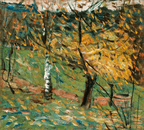
Den vita björken, 1902
(The White Birch) -
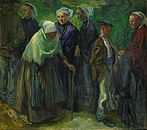
Bretagnare I, 1905
(Bretons I) -
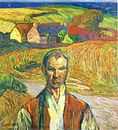
Bonden i Bretagne, 1905
(Farmer in Brittany) -

Självporträtt, 1905
(Self-portrait) -
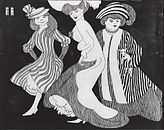
Kokotter, 1905
(Coquettes) -

Nattcafé I, 1905–1906
(Night Café I) -
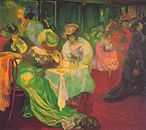
Nattcafé II, 1906
(Night Café II) -
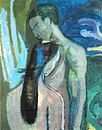
Ungdom, 1919
(Youth) -
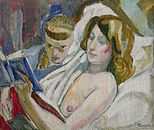
Sagostund, 1919
(Storytime) -
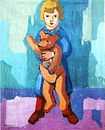
Algot med teddybjörn, 1921
(Algot with teddybear) -
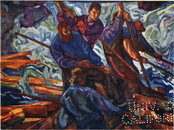
Timmerflottare, 1921
(Timber floaters) -
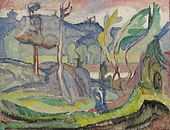
Skuggor, 1925
(Shadows) -
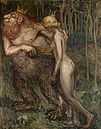
Trollkungen och prinsessan, 1925
(The Troll King and the Princess) -
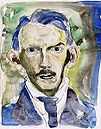
Självporträtt (watercolour)
(Self-portrait) -
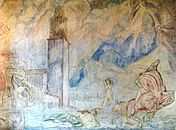
Stadshuset bygges, kalkmålning i "Blåa rummet" intill Gyllene salen
(City Hall is Built, Stockholm City Hall, fresco in the "Blue Room" next to the Golden Hall)
- ^ Art in Kiruna. Accessed 2012-12-19. (in Swedish) (Google translate)
See also
- Moderna Museet
- Blue Room in Stockholm City Hall
- Kiruna City Hall
- Swedish art
- List of Swedish artists
- Swedish language Wikipedia
- Nationalencyklopedin
References
- ↑ 1.0 1.1 1.2 1.3 1.4 1.5 1.6 1.7 1.8 1.9 1.10 1.11 1.12 Jonna Säll, 2011, "En av de viktigaste banbrytarna för svensk konst" [in Swedish; Engl., "One of the most important pioneers of Swedish art"], at Nya Wermlands-Tidningen (online magazine), June 18, 2011, see – via (subscription required) and translate, – via (subscription required) , accessed 21 April 2015.
- ↑ 2.0 2.1 2.2 2.3 2.4 2.5 2.6 2.7 2.8 Hans Alexander Gerlanius, 2015, "Johan Axel Gustaf Törneman" (biographical entry), at Konstnärslexikonett Amanda (online) [biographical dictionary of Swedish/Nordic artists, in Swedish], see and translate, accessed 21 April 2015.
- ↑ Landi, Ann, Auto-Destructive Tendencies, "Whether by burning, cutting, shredding, or simply leaving them at the curb, artists have various reasons for disposing of their own work", ARTnews, artnews.com, 24 December 2012. Accessed 2013-1-10.
See also, Livingston, Paisley, and Archer, Carol, Artistic Collaboration and the Completion of Works of Art, British Journal of Aesthetics, 50(4), October 2010, pp. 439–455, Oxford University Press. Accessed 2013-1-10. doi:10.1093/aesthj/ayq029; and Unfinished creative work. - ↑ Brinton, Christian, The Swedish art exhibition, Brooklyn Museum, 1916, p. 20. Accessed 2012-12-19.
- ↑ Röstorp, Vibeke, Les Artistes Suédois et Norvégiens en France de 1889 à 1908, Le Mythe du Retour (Swedish and Norwegian Artists in France from 1889 to 1908, The Myth of Return), PhD thesis, univ-paris4.fr, 2011, p. 7. Accessed 2012-12-19. (in French) (Google translate)
- ↑ Gösta von Hennigs, Spansk dans listing at auktionsverket.com, Lot number 665 accompanying text; and Leander Engström, Falken, regnbågen, Lot 690 accompanying text. Accessed 2013-1-11.
- ↑ Scenes from Venice (1912) was auctioned in December 2012 for 9,300 SEK. See , accessed 21 April 2015.
- ↑ Bonetto, Cristian, Stockholm: encounter, Lonely Planet Encounter Series, Lonely Planet, 2007, p. 41. ISBN 9781741792102.
- ↑ 9.0 9.1 9.2 9.3 9.4 Lindqvist, Svante, The Archeology of symbols at the Wayback Machine (archived March 28, 2010), Industriminne, Industrial Heritage Society, The Journal Nordic Museology, 2:2003, pp. 27–50 at pp. 35–41. Partial archive of the original via archive.org. Accessed 2012-12-19.
- ↑ Michael Williams, 1915, A brief guide to the Department of Fine Arts: Panama–Pacific International Exposition, San Francisco, 1915, San Francisco, CA: Wahlgreen, p. 61, see , accessed 21 April 2015.
- ↑ Törneman's collection, National Library of Sweden, accessed 2012-12-19.
Further reading
Exhibition catalogs
- Axel Törneman och kvinnan, Moderna museet, Exhibition Catalog, Stockholm, 1965. OCLC 3138236.
- Moser, Claes, and Newall, Christopher, Axel Törneman, an Eccentric Swedish Colourist: 17 May to 1 June 1989, Leighton House Museum. (exhibition catalog) OCLC 77608134
- Söderlund, Göran, ed., Axel Törneman. Millesgården, Stockholm, 1990. Cat. no. 24. (exhibition catalog) ISBN 9789187340222.
- Theorell, Anita, et al., Axel Törneman, Millesgården, Stockholm, 1990. (utställningskatalog) (exhibition catalog).
Other works
- Axel Törneman : artist file, study photographs and reproductions of works of art with accompanying documentation 1920–2000, Frick Art Reference Library of The Frick Collection. Accessed 2012-12-19. OCLC 84495008
- Theorell, Anita, Studier kring Axel Törnemans Riksdagshus Målningar, (Studies on Axel Törneman Parliament building's Paintings; academic dissertation), Stockholm, 1973 (Museum Stavanger Biblioteket, Norway, (STAVMUS, bibl, 75(485))).
- Källström, Magnus, Nattcafé. Om Axel Törnemans tid i Paris 1902 – 1906, Stockholm 1988. (Night Café. Axel Törnemans's time in Paris)
- Källström, Magnus, Torgny Lagman: Axel Törnemans ma°lningar i riksdagshuset, (Parliament House), Stockholm, Sandler, 1990. ISBN 9789187790201.
- Rausing, Birgit, et al., Signums svenska konsthistoria, Konsten 1890 – 1915, Lund 2001, s. 283ff, (Signums Swedish art history), ISBN 9789187896460.
- Axel Törneman, Några anteckningar om vännen och vapenbrodern i kampen för den unga konsten. Sångerskan, Gudrun Høyer-Ellefsen, tillägnade; portion in book: Norlind, Ernst, Intermezzon och bagateller, Stockholm, 1907, p. 61. Accessed 2012-12-19. (Includes a caricature of Törneman at work with caption: "Axel Törneman, Some notes about your friends and brothers in arms in the fight for avant garde art" and signed "Gudrun Høyer-Ellefsen" (his wife)) (whole Google book)
- Axel Törneman, Search, New York Art Resources Consortium, arcade.nyarc.org. Accessed 2012-12-20.
External links
| Wikimedia Commons has media related to Axel Törneman. |
- Troll Painters, Axel Törneman (1880–1925), short essay on the work The Troll King and the Princess, 1905. Accessed 2012-12-19.
- Norra Latin mural. Accessed 2012-12-19.
- Axel Törneman Auction results, Stockholms Auktionsverk, auktionsverket.com. Accessed 2012-12-20.
- Axel Törneman Auction results, Artnet.com. Accessed 2012-12-20.
- Vid pianot, (At the Piano), an unsold Törneman work estimated pre-auction at 500,000 to 600,000 kr; Stockholms Auktionsverk, 2011-12-06. Accessed 2012-12-19. (in Swedish) (Google translate)
|
| ||||||||||||||||||||||||||||||||||||||||||
| |||||||||||||||||||||||||||||||||||||||||
